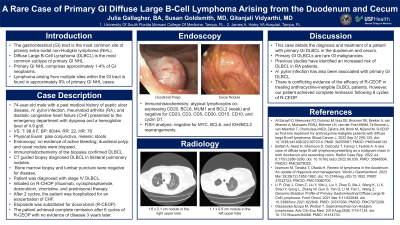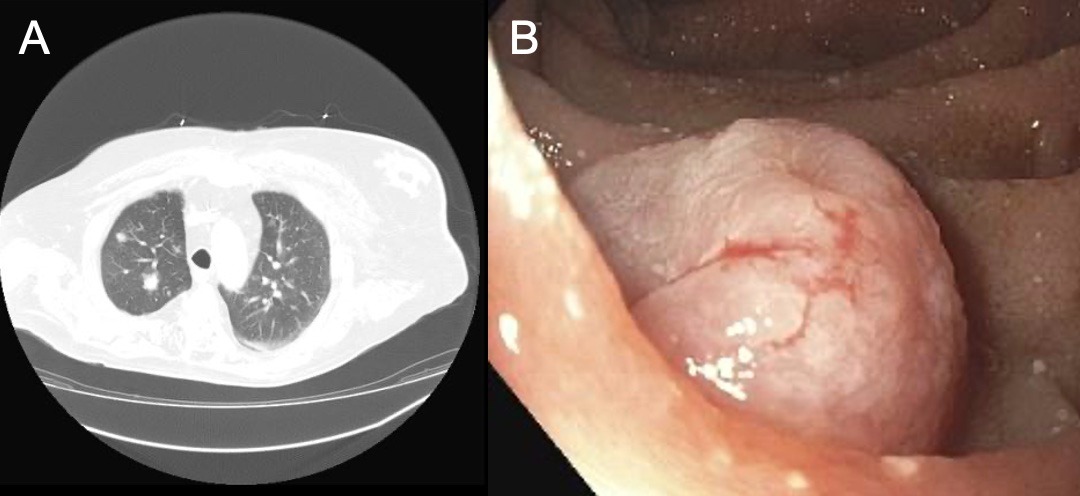Tuesday Poster Session
Category: General Endoscopy
P3424 - A Rare Case of Primary GI Diffuse Large B-Cell Lymphoma Arising From the Duodenum and Cecum
Tuesday, October 24, 2023
10:30 AM - 4:00 PM PT
Location: Exhibit Hall

Has Audio
- JG
Julia E. Gallagher, BA
University of South Florida Morsani College of Medicine
Tampa, FL
Presenting Author(s)
Julia E. Gallagher, BA1, Susan Goldsmith, MD2, Gitanjali Vidyarthi, MD2
1University of South Florida Morsani College of Medicine, Tampa, FL; 2James A. Haley Veteran's Hospital, Tampa, FL
Introduction: The gastrointestinal (GI) tract is the most common site of primary extranodal non-Hodgkin lymphoma (NHL), with diffuse large B-cell lymphoma (DLBCL) being the most common subtype. However, primary GI NHL comprises approximately 1-4% of GI neoplasms. Lymphoma arising from multiple sites within the GI tract is a rare occurrence found in approximately 9% of primary GI NHL cases. We present this case report to detail the diagnosis, presentation, and treatment of a patient diagnosed with DLBCL of both the duodenum and cecum.
Case Description/Methods: A 74-year-old male with a past medical history of peptic ulcer disease, H. pylori infection, rheumatoid arthritis (RA), and diastolic congestive heart failure (CHF) presented to the emergency department with dyspnea and a hemoglobin level of 4.9 g/dl. The patient was afebrile with a blood pressure of 80/44, respiratory rate of 22, and heart rate of 76. Physical exam findings were notable for pale conjunctiva and melenic stools. The patient underwent an EGD and colonoscopy. The procedures did not reveal any evidence of active bleeding; however, a duodenal polyp and cecal nodule were biopsied. Immunohistochemistry of the biopsies confirmed DLBCL with atypical lymphocytes co-expressing CD20, BCL6, MUM1 and BCL2 (weak) and negative for CD23, CD3, CD5, CD30, CD15, CD10, and cyclin D1. FISH analysis was negative for MYC, BCL6, and IGH/BCL2 rearrangements. A CT scan revealed bilateral pulmonary nodules, which were diagnosed as DLBCL following CT guided biopsy. Bone marrow biopsy and lumbar puncture were negative for disease. Following the patient’s diagnosis, R-CHOP therapy (rituximab, cyclophosphamide, doxorubicin, vincristine, and prednisone) was initiated. After completing 2 cycles, the patient was hospitalized for an exacerbation of CHF. Subsequently, etoposide was substituted for doxorubicin (R-CEOP). The patient achieved complete remission after 6 cycles of R-CEOP and has no evidence of disease 3 years later.
Discussion: Primary GI DLBCLs are rare GI malignancies. Previous studies have identified an increased risk of DLBCL in RA patients. Additionally, H. pylori infection has also been associated with primary GI DLBCL. Thus, our patient had multiple risk factors associated with the disease. However, further studies are needed to elucidate the etiology of multifocal primary GI NHLs.

Disclosures:
Julia E. Gallagher, BA1, Susan Goldsmith, MD2, Gitanjali Vidyarthi, MD2. P3424 - A Rare Case of Primary GI Diffuse Large B-Cell Lymphoma Arising From the Duodenum and Cecum, ACG 2023 Annual Scientific Meeting Abstracts. Vancouver, BC, Canada: American College of Gastroenterology.
1University of South Florida Morsani College of Medicine, Tampa, FL; 2James A. Haley Veteran's Hospital, Tampa, FL
Introduction: The gastrointestinal (GI) tract is the most common site of primary extranodal non-Hodgkin lymphoma (NHL), with diffuse large B-cell lymphoma (DLBCL) being the most common subtype. However, primary GI NHL comprises approximately 1-4% of GI neoplasms. Lymphoma arising from multiple sites within the GI tract is a rare occurrence found in approximately 9% of primary GI NHL cases. We present this case report to detail the diagnosis, presentation, and treatment of a patient diagnosed with DLBCL of both the duodenum and cecum.
Case Description/Methods: A 74-year-old male with a past medical history of peptic ulcer disease, H. pylori infection, rheumatoid arthritis (RA), and diastolic congestive heart failure (CHF) presented to the emergency department with dyspnea and a hemoglobin level of 4.9 g/dl. The patient was afebrile with a blood pressure of 80/44, respiratory rate of 22, and heart rate of 76. Physical exam findings were notable for pale conjunctiva and melenic stools. The patient underwent an EGD and colonoscopy. The procedures did not reveal any evidence of active bleeding; however, a duodenal polyp and cecal nodule were biopsied. Immunohistochemistry of the biopsies confirmed DLBCL with atypical lymphocytes co-expressing CD20, BCL6, MUM1 and BCL2 (weak) and negative for CD23, CD3, CD5, CD30, CD15, CD10, and cyclin D1. FISH analysis was negative for MYC, BCL6, and IGH/BCL2 rearrangements. A CT scan revealed bilateral pulmonary nodules, which were diagnosed as DLBCL following CT guided biopsy. Bone marrow biopsy and lumbar puncture were negative for disease. Following the patient’s diagnosis, R-CHOP therapy (rituximab, cyclophosphamide, doxorubicin, vincristine, and prednisone) was initiated. After completing 2 cycles, the patient was hospitalized for an exacerbation of CHF. Subsequently, etoposide was substituted for doxorubicin (R-CEOP). The patient achieved complete remission after 6 cycles of R-CEOP and has no evidence of disease 3 years later.
Discussion: Primary GI DLBCLs are rare GI malignancies. Previous studies have identified an increased risk of DLBCL in RA patients. Additionally, H. pylori infection has also been associated with primary GI DLBCL. Thus, our patient had multiple risk factors associated with the disease. However, further studies are needed to elucidate the etiology of multifocal primary GI NHLs.

Figure: A. Axial CT demonstrating a 1.6 x 2.1 cm nodule in the right upper lobe. B. Duodenal polyp from endoscopic imaging.
Disclosures:
Julia Gallagher indicated no relevant financial relationships.
Susan Goldsmith indicated no relevant financial relationships.
Gitanjali Vidyarthi indicated no relevant financial relationships.
Julia E. Gallagher, BA1, Susan Goldsmith, MD2, Gitanjali Vidyarthi, MD2. P3424 - A Rare Case of Primary GI Diffuse Large B-Cell Lymphoma Arising From the Duodenum and Cecum, ACG 2023 Annual Scientific Meeting Abstracts. Vancouver, BC, Canada: American College of Gastroenterology.

